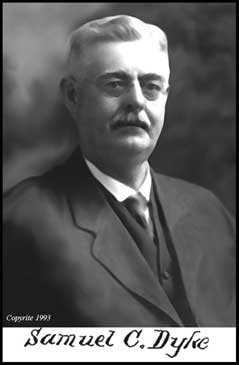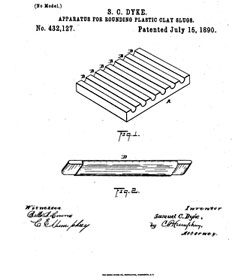
ABOVE: Samuel Comely Dyke (1856-1924) |
Akronite Samuel C. Dyke ignited the
modern toy industry when he automated his factory in 1884. Toy marbles
have been around for thousands of years; however, until recently, they
were very expensive to produce because they were created by hand:
one-marble-at-a-time. Sam Dyke changed all that when he invented
machinery to fully mass-produce toy marbles made out of clay, later to
become nick-named "commies" by the children who were enthralled by them
(because they became so common among all the varieties of
marbles to be eventually produced).
A few years after the much neglected
Ohio canal system had been returned to the state, in 1884, Samuel C.
Dyke opened shop on the grounds of the old lumber yard that had once
been Lock 3. His factory turned out the first mass-produced toy, clay
marbles, which were manufactured for sale to the Merrill Pottery, one of
the largest potteries in the United States at the time (and the business
right next door).
This sudden mass-production caused the price of a toy to dramatically
plummet -- so much so that, for the first time in history, many children
could afford to buy a toy with their own money. (A penny bought a
handful of clay marbles.) The success of Dyke's Akron Toy Company
spurred other entrepreneurs to start up their own marble works in the
Akron area. A few years later, in 1891, Sam Dyke founded The American
Marble & Toy Manufacturing Company, and it was this factory
that became
the largest toy company to operate in the United States during the
nineteenth century.

ABOVE:
Clay marbles discovered in the Akron area. BELOW:
Click on the image below to explore these antique toys now
preserved at the museum.

|
With a capitol stock of $100,000.00
and an employment of roughly 350 "hands" (350 people), most of whom were
women and children. In addition to making glazed stoneware, the business
made earthy miniature replicas of such items as: jugs, pots, boots,
shoes, dogs and cats -- which at the time were considered children's
toys. The company also produced "china" marbles, made of porcelain,
which became the finest shooter marbles available at the time. However,
the corporation's primary products were common clay toy marbles, called
"commies."
Around the same time, leading members
of the rubber industry took notice of this new children's market and
soon were turning out the first mass-produced rubber toys, such as:
rubber balloons, rubber balls, rubber dollies, rubber duckies and rubber
baby buggy bumpers. The children's market also opened up with the mass
production of cast iron toys, tin toys, bicycles, other peddle toys,
tops, and children's books. Other companies expanded the market into
adult play to include sporting goods such as golf balls and fishing
tackle.
In total, our research has identified almost 100 toy companies that
operated within the greater Akron area since 1884; of that number,
roughly 1/3 (three dozen) of them were marble works. These factories
made all types and styles of marbles, from mass-produced clay and stone
marbles to both hand-made and machine-made glass marbles.

ABOVE:
A U.S. Patent for a devise to mass-produce clay marbles.
Marbles were rolled in the block until they attained a
near-perfect symmetry. The patent was filed by S.C. Dyke on
July 15, 1890, one year before he opened the new factory. |
Each day, the employees manufactured
one million marbles. One million marbles is enough to fill five railroad
box-cars. Five railroad boxcars rolling out of the factory once-a-day,
filled with these clay toy marbles, made The American Marble & Toy
Manufacturing Company the largest toy company to operate in the United
States during the nineteenth century.
However, on one unlucky day in 1904,
thirteen years after it had been incorporated, The American Marble & Toy
Manufacturing Company burnt to the ground. This unfortunate event
appeared, to some young pilferers, to be a great day for marble
collectors: the next morning, every little boy in Akron came down to
scavenge and fill his pockets with marbles. This was no play ground, far
from being a safe place for such innocent children to be hanging (and
looting) about. The police were called in to keep these treasure hunters
from unlawfully appropriating the marbles, and soon after, the city
ordered the charred remains of the factory to be buried.
There are still toy companies in the Akron area today: Little Tykes,
Step Two, Eagle Rubber, Ashland Rubber are just a few of these thriving
toy companies. However, Akron's last marble company, The Akro Agate Co.,
closed its doors in 1951.(Michael Cohill & Carol Robinson)
Toy Marble Companies Represented at The American Toy Marble Museum:
The Akron Toy Co., The S.C. Dyke & Co., Dyke's Stoneware Specialty
Co., The Mishler Brothers Terracotta Works, The Limaville Marbles &
Terracotta Works, The Albright & Lightcap Co., The J.E. Albright Co.,
The American Marble & Toy Manufacturing Co., The East End Marble Co.,
The Akron Stone Marble Co., The Akron Marble and Novelty Co., The
Standard Toy Marble Co., The M.A. Knight Co., Brownís Marbleworks, The
Akron Insulator and Marble Co., The M.F. Christensen & Son Co., The
Akron Glass and Machinery Co., The Akro Agate Co., The Christensen Agate
Co., James Harvey Leightonís Glass & Toy Marbleworks, Hobbs Brockunier &
Co., The Buckeye Glass Works, The Eagle Glass Works, Iowa City Glass
Works, The Ottawa Glass Works, The Bellmont Glass Works, The S.C. Dyke &
Co., The American Marble and Toy Manufacturing Co., The Akron White Sand
and Stone Co., The Akron Marble and Novelty Co., The Medina Glass
Novelty Co., The Kent Glass Novelty Co., The J.H. Leighton & Co., The
Navarre Glass Marble and Specialty Co., The M.F. Christensen & Son Co.,
The American Glass Marble Co., The American Marble Co., The National
Marbles & Specialty Co., The Barberton Glass Novelty Co., The Shadyside
Glass Novelty Co.
|
